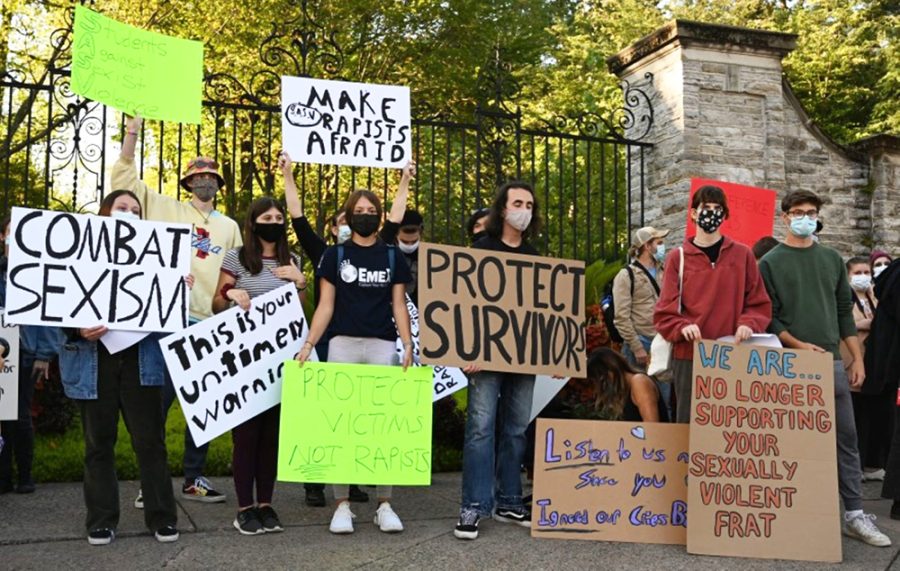Sexual Assault – increasing on college campuses
Sexual assaults, domestic violence, dating violence and stalking are serious problems on college campuses. According to the U.S. Department of Justice, 20 to 25 percent of female undergraduates will be the victim of sexual assault or attempted sexual assault this year and in nearly all cases it will be by an acquaintance.
January 15, 2022
Sexual assault on college campuses is a frequent issue that often goes unreported. Generally, sexual assault is defined as any unwanted sexual contact. This form of abuse comes in many different forms on college campuses. Students may feel peer pressure to participate in social activities, such as drinking and drug use or engaging in uncomfortable sexual activities by coercion.
Being forced to participate in undesired sexual activity for social acceptance is a form of sexual coercion. The Collins dictionary defines it as any type of non-physical pressure used to make you feel as if you have no choice but to participate in sexual activity despite your disinterest, unwillingness, or protests.
The National Center for Victims of Crime states, “Sexual assault takes many forms, including attacks such as rape or attempted rape, as well as any unwanted sexual contact or threats.”
It is important to note that sexual assault happens everywhere, to women and men of all ages. The U.S. Department of Health and Human Services reports it is common on college campuses and occurs most often to college-aged women between the ages of 18 and 24. Being aware of safety measures and post-assault options is vital to ensure the safety and well-being of potential victims.
Students at Alabama State University share their views on the importance of being precautious when attending campus and local events.
“I have heard a lot of scary stories about girls who have been taken advantage of after drinking at parties and being left alone,” begins sophomore criminal justice major, Desiree Moore. “My friends and I make it a priority to stay together when we go out, especially if there is alcohol involved.
According to statistics provided by bestcolleges.com, “On average, sexual assault occurs every 73 seconds in America.” Campus sexual assault often involves alcohol and drugs. One study done by the U.S. Department of Health and Human Services found that 15% of young women were victims of incapacitated rape during their freshman year of college. Being incapacitated means the victims were raped when they could not give consent because they did not know what was happening. Many students try alcohol or drugs for the first time during college and may abuse their limits simply because they are inexperienced. Using drugs or drinking an excessive amount of alcohol can make you unaware of your surroundings and more susceptible to sexual assault if not careful.
“It’s really sad when someone gets assaulted on campus, and the victim is too afraid to tell anyone because of all the backlash that they will face or being afraid that no one will believe them,” notes junior biology major Samia Little. “When an assault is done by someone who is well-liked at the university, it’s not hard to see why some people are scared to report them.”
In the unfortunate case that a student or someone close to them gets assaulted, it is significant to identify some potential options. Reporting sexual assault is vital. Only one in five college-aged women who are sexually assaulted report the attack to the proper authorities. While talking about sexual assault to strangers can be difficult, reporting it can prevent assaulters from harming others and help students reclaim some of their control. In addition, university jurisdiction can make arrangements to avoid contact between the victim and the assaulter.
“The university has to be just as concerned about the sexual safety of its students as it is with other things,” said junior psychology major Makayla Carter. “That includes holding offenders responsible, no matter who they are, and refraining from intimidation tactics that are used against victims who attempt to report an assault. It is seriously damaging to be assaulted and then have to go through an impossible process to try and get justice. The criminal justice department can definitely use some work when it comes to dealing with sexual violence on campus.”
Of course, the role of any university should be to prioritize and ensure the health and safety of its student body. The Center for Disease Control and Prevention provides some preventative protocols to increase assault prevention on campus, which include the use of well-trained staff members. Having staff members trained in violence prevention can consist of knowledge of the public health approach, sexual assault program evaluation, and awareness on strategies that prevent sexual violence. In addition to a well-trained staff, it is significant to ensure that students, staff, and administrators are receiving appropriate training for their role in prevention and the prevention guidelines are consistent and reinforced over time. Provide prevention training to incoming students and new employees, but do not limit it to a one-time lesson. Prevention education should be ongoing and delivered in multiple ways.
Sexual violence includes a myriad behaviors such as attempted or completed rape, sexual coercion, unwanted contact, and harassment. Preventing sexual violence of all types requires a shift in culture and climate. Primary prevention, or the prevention of violence before it occurs, is difficult but not impossible. Cultural change does not happen overnight but bringing awareness to such a common issue and improving campus protocols serve as the first step toward preventing the next potential victim of sexual assault on college campuses.







